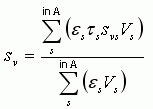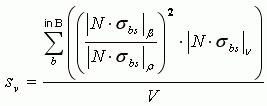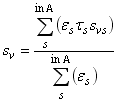Sv_mean
Let A be the set of samples s in the analysis domain over which the mean Sv is to be calculated.
The methods of calculating the mean Sv are as follows:
|
used for Sv mean calculations on single beam data |
|
|
used for Sv mean calculation on multibeam data (except for target-locked data) |
|
|
used for Sv mean calculation on target-locked scanning data |
In all cases calculations are performed in the linear domain not the decibel domain. See Conversions below for details.
Note: The Maximum Data threshold set on the Data page of the Variable Properties dialog box will affect the calculation of Sv_mean.
-
If the Maximum threshold is set to No data the thresholded values are excluded from the calculation of Sv_mean.
-
If the Maximum threshold is set to Threshold limit, all samples that are above the maximum threshold are converted to the threshold limit value and included in the Sv_mean calculation.
Sv_mean (single beam data)
This calculation is used for calculating the mean Sv from single beam data.
Where:
= The linear mean Sv for all samples in the domain A (m2/m3) - see Conversions below. = the set of samples in the analysis domain. svs = The linear Sv value for sample s (m2/m3) - see Conversions below. = 0 if sample s is excluded from analysis of the domain 1 otherwise, including Bad data (empty water samples) = 0 if sample s is below the specified Minimum threshold. 1 otherwise
Considerations for single beam data integrations
There are several considerations used for integrating single beam data. They are as follows:
-
The analysis domain is affected by exclusion lines. Analysis settings may also affect samples and bad data regions. See About analysis domain for further information.
-
The single beam algorithm assumes each sample is representative of an equal volume of water. That is, no weighting is applied for sample volume, Vs = 1 (see Volume_integration). Warning: This includes the implicit assumption of equal ping spacing and equal sample thickness for all samples being integrated. That is, the mean Sv calculation will exhibit a bias if any of the following are not constant for every sample and ping in the integration:
- the ping rate
- the vessel speed
- the sample thickness (a function of the sample interval or rate, and sometimes the pulse duration)
Sv mean (multibeam data)1
This calculation is used for calculating the mean Sv from multibeam data. For target-locked scanning data see Sv mean (target-locked multibeam) below.
Calculate the mean as follows:

Where:
sv = The linear mean Sv for all samples in the domain A (m2/m3) - see Conversions below.
A = the set of samples in the analysis domain.
svs = The linear Sv value for sample s (m2/m3) - see Conversions below.
Vs = Volume of sample s (m3) - see Volume_integration for method of calculation
= 0 if sample s is excluded data, Bad data (no data) or no data 1 otherwise, including Bad data (empty water) samples = 0 if sample s is below the specified minimum threshold 1 otherwise.
See also: Exclusions, Bad data, No data and Minimum threshold.
Considerations for multibeam data integrations
There are several differences between the algorithm used for integrating multibeam data and that used for integrating single beam data. They are as follows:
-
Different kinds of analysis domain are available. See About analysis domain for further information.
-
Multibeam data does not support Bad data.
-
The multibeam algorithms weight each individual Sv sample for the sample volume. Echoview provides several distinct algorithms for estimating the sample volume Vs. See Volume_integration for details.
Sv mean (target-locked data)
This calculation is used for calculating the mean Sv from target-locked scanning data only. For single beam or multibeam data see Sv mean (single beam, multibeam*) above.
The following definition is made for the purposes of the calculation:
| Let |  |
Where:
| = the net backscattering cross-sectional area for all the samples in set α (m2) | |
| α | = the set of samples s under consideration (being analyzed) |
| svs | = The linear Sv value for sample s (m2/m3) - see Conversions below. |
| Vs | = Volume of sample s (m3) - see Volume_integration for details. |
Then the mean Sv is calculated as follows:

Where:
sv= The linear mean Sv for all samples in the domain (m2/m3) - see Conversions below.
B = the set of beams in the analysis domain and on the H-mode ping
β = the set of samples in the analysis domain and on the H-mode ping in the beam b
ρ = the set of samples in the analysis domain and on the H-mode ping in the beam which intersects with the V-mode ping
ν = the set of samples in the analysis domain and on the V-mode ping
V = the integration volume (m3)
Conversions
All calculations of mean Sv are conducted in the linear domain. Individual samples are converted from the decibel domain as follows:
![]()
Where:
svs = The linear Sv value for sample s (m2/m3)
Svs = The Sv value for sample s (dB re m2/m3)
and the result is converted back to the decibel domain as follows:
![]()
Where:
sv = The linear mean Sv as calculated above (m2/m3)
Sv = The mean Sv, Sv_mean (dB re m2/m3)
See also
About analysis domains
Samples
Sample_mean
NASC and ABC
Footnote:
1 Except for Target-locked data

